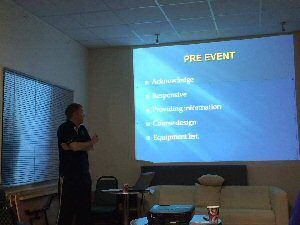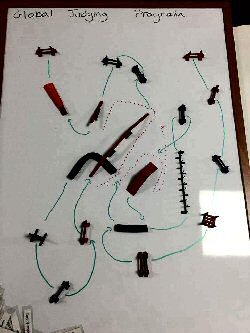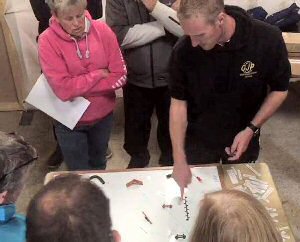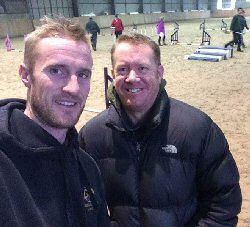Designed by judges
for judges...
 Week
after week, agility judges all around the country set courses to test of our
ability. If we struggle, we can go away and train these challenges further. So
surely developing our judges so they set safe and appropriate yet challenging
courses is in all our interests? Most judges will at some point have taken
assessments or exams and following successful completion gone off to judge. And
that, for the majority, is where their professional development ends as there
has been nothing to cater for them in this regard. Until now... Becky Dixon
reports on the Global Judging Program (GJP). Week
after week, agility judges all around the country set courses to test of our
ability. If we struggle, we can go away and train these challenges further. So
surely developing our judges so they set safe and appropriate yet challenging
courses is in all our interests? Most judges will at some point have taken
assessments or exams and following successful completion gone off to judge. And
that, for the majority, is where their professional development ends as there
has been nothing to cater for them in this regard. Until now... Becky Dixon
reports on the Global Judging Program (GJP).
The Global Judging
Program is the brainchild of Greg Derrett and Lee Gibson, both extremely
well-known and successful names in the agility world. In the introduction of the
2 day initial seminar, they detail how important they think the role of judging
is in shaping British agility now and in the future which is one of the reasons
they have developed the programme. GJP is not aimed at judges from any specific
organisation and those attending so far - approximately 100 people - have ranged
from brand new judges to Kennel Club CC judges.
Lee and Greg launched
GJP with a two day seminar in early 2016 which I attended. In 2017 they have now
also introduced a two day follow up Advanced Seminar with assessments allowing
participants to work towards achieving GJP Approved or Affiliated Judge status.
It was clear from the outset how passionate Greg and Lee are about improving the
standard of judging in this country at all levels, as well as supporting our
judges who are subject to increasing pressure from all angles nowadays,
especially given the advent of social media.
This seminar was a
great refresher of things I knew and things I thought I knew. However, it also
developed a number of discussion points about things that I wasn't so sure about
or didn't have so much confidence in. In addition a number of new thoughts and
ideas were generated by the seminar.
The initial seminar was
broken down into a number of modules - all delivered in an interactive and
enjoyable way. It was a lot to get through, but the timetable was well thought
out and enough breaks were provided.
 Modules
included:- Modules
included:-
-
Expectations from a Show Manager
-
Judging in 2016 (now updated to read 2017
I imagine!)
-
Skills Setting
-
Safety and Judge's Position
-
Confrontation and Social Media
-
Refusal Clarification
-
Video Judging
-
Judging Scenarios
-
Quick Fire Questions
-
Adapting Course Plans
Of particular note for me was the module on
Skill Setting in which we received individual feedback on courses we had
submitted prior to the course. We were then given a piece of work to complete in
the group in relation to our own courses. For me, this increased my confidence
in making calls about what I wanted to test in my course and then taking an
overall look at the course and seeing how well set the skills were in order for
me to achieve my aim.
Confrontation and social media was a highly
engaging and humorous module with very good visual learning aids. There were
really good examples of how easy it is to get embroiled into a discussion on
social media and how this can escalate. This module was great and provoked good
discussion within the group.
Safety and judges path was another module
which was very thought provoking. There were some really detailed discussions
about safety issues that may not be so obvious and actual safety versus
perceived safety were also key points. The importance of an appropriate and
effective judge's path were also covered in this module. This linked in well
with the previous module where we had submitted our own courses. We faced
discussion about the judge's path we had chosen and how effective that was in
practise. It may seem obvious but I am sure we have all seen examples of courses
which are very difficult for anyone to judge effectively!
 Video
judging was an opportunity to look at dogs runs and make calls on whether we
would fault or not. It was then possible to see the video in slow motion and
discuss the calls we had made and why. Although in real life we obviously don't
have the benefit of a slow motion replay it was extremely useful in this forum
to clarify why we would or wouldn't make a certain call. I particularly liked
this as the trainers had found examples of a number of different and difficult
calls. I have previously seen how difficult it is to appropriately test a judges
skills in a practical judging session as it can be very difficult to get dogs to
perform certain faulting behaviours in a mock situation. By scrolling through
hours of video the trainers had found some challenging decisions for us to
judge. The pressure was still on as we had to make the call in real time and
then see it back in slow motion after we had done this. Video
judging was an opportunity to look at dogs runs and make calls on whether we
would fault or not. It was then possible to see the video in slow motion and
discuss the calls we had made and why. Although in real life we obviously don't
have the benefit of a slow motion replay it was extremely useful in this forum
to clarify why we would or wouldn't make a certain call. I particularly liked
this as the trainers had found examples of a number of different and difficult
calls. I have previously seen how difficult it is to appropriately test a judges
skills in a practical judging session as it can be very difficult to get dogs to
perform certain faulting behaviours in a mock situation. By scrolling through
hours of video the trainers had found some challenging decisions for us to
judge. The pressure was still on as we had to make the call in real time and
then see it back in slow motion after we had done this.
Judging scenarios was
another session where we were put under pressure to make good decisions. Being
faced with a situation and asked what we would do in that situation was enhanced
by the trainers reacting to whatever we said as another person present might.
This reinforced the need to be acutely aware of what we were saying as people
can seize on our comments and further challenge us about them, as was
demonstrated by Lee and Greg on several occasions!
Quick fire questions was the one that a lot
of us were nervous about. However, the support given by Greg and Lee and the
rest of the course was fantastic. One by one we had a number of questions fired
at us for one minute to see how many we could get right. These were all
answerable with 5, 5R, E or no fault. A really important learning point from
this was about not dwelling on a mistake we may have made as it could affect our
performance further and I think a lot of us learnt from this. It also replicated
the very quick decisions that judges are required to make many times a day.
I came away from it determined to improve my
skills at judging by incorporating all that I had learnt into future
appointments. I had never lost my love of judging, but I think this course
re-identified for me the importance of being a good judge, both in being a good
role model to others and in developing the sport for the future.
And so, one year later, I decided to apply
for the Global Judging Program Advanced Seminar and assessments which ran in
January 2017. Having people attend a seminar is great but just because someone
has attended a training workshop doesn't mean that they will be able to
put what they had learned into practise. Greg and Lee wanted to put into place a
program to accredit people to Global Judging standards and develop excellent
judges rather than just 'okay' judges. To that end they made no apologies for
what we were about to experience. It was clear from the outset that the standard
was set high.
Day 1 - Advanced GPJ
Seminar 2017
The first day included topics we had covered in the initial seminar
such as Course Design, Refusals, Judge's Path and Positioning, Measuring and
Dogs Lines as well as the course design process.
 Course
design was based around a template we had been given before we attended with ten
pieces of equipment on it which we could not move. We were asked to design a
Grade 6 Agility course using this as a basis. It was really interesting to look
at each other's courses and see the amount of variation in them. It was also a
key part of the session to evaluate our own and others courses in relation to
the difficulty level, the skills set, the safety aspects and the judge's path as
well as any other feedback that was useful. Course
design was based around a template we had been given before we attended with ten
pieces of equipment on it which we could not move. We were asked to design a
Grade 6 Agility course using this as a basis. It was really interesting to look
at each other's courses and see the amount of variation in them. It was also a
key part of the session to evaluate our own and others courses in relation to
the difficulty level, the skills set, the safety aspects and the judge's path as
well as any other feedback that was useful.
Refusals was a very interactive session where
we were asked to bring examples of refusals that we would like clarified. A
series of video clips were also shown which we made calls on and discussed to
see how accurate we were. Again we got to see these in slow motion later so we
could better understand what had actually happened.
With course measuring being a very current
topic we spent time discussing different organisations requirements in relation
to course measuring, the differences in minimum and maximum distances and then
undertook a practical course measuring session using both the dogs path method
and the centre to centre method. This was a very useful exercise and helped us
all to realise how we can impact on course times, progression etc. by good or
poor measuring.
At the end of the day, Lee and Greg talked
through the assessments we would face on Day 2. There were 11 in total:- Judges
path, Safety issues, See-saw Calls, Measuring x 2 (centre to centre and dogs
path), Judging Scenarios, Quick Fire Questions, Refusal Calls, Equipment Failure
and two submitted courses.
A score of 80% or more in a test would gain
us a marking of excellent, 65-79% would be good, 45-65% average and below 45 %
would be a fail. There were two levels of accreditation. In order to become a
GJP Approved judge we needed to get an excellent in 8 or more of the 11 modules
and no fails. In order to become a GJP Affiliated judge, we needed to get an
excellent or a good in eight or more of the 11 modules and not more than one
fail. Cue gulps around the room! A number of us stayed up late that night
reviewing at the two courses we had already designed and developing them further
based on what we had learned earlier that day.
Day 2 was a very
different day
It was clear that there were a lot of nerves in the room. The day
started with us all submitting our two courses for our first assessment. We then
moved quickly on to a 25 minute written paper on Judge's Path and Safety Issues.
with a number of different courses and asked to mark judge's path and safety
calls on them. This was difficult as there were parts of the course that you
probably wouldn't have designed as a judge due to poor equipment placement. It
really made me think about where I needed to be to judge as effectively as
possible. It was tough but it got us all settled down fairly quickly.
We then moved onto See-saw Calls. This was an
assessment where we watched video from UKI in America and marked down what call
we would have made. No slow motion on this one unfortunately until after we had
handed our assessments in. However having the opportunity to watch them back in
slow motion gave us a sense of how we might have done on the assessment.
 The
measuring assessments were done at two different times in the day. We were given
a course plan and a few minutes to walk the course. We then had to measure it,
on one occasion using the dog's path method and on the other using the centre to
centre method. All of the measuring was done individually out of sight of all
the other course members, As we got to the finish line we had to submit our
measurement to Greg who was waiting for us. On centre to centre method we had to
be within 2 metres of what the trainers had measured to score excellent and on
dog's path within 3 metres. The
measuring assessments were done at two different times in the day. We were given
a course plan and a few minutes to walk the course. We then had to measure it,
on one occasion using the dog's path method and on the other using the centre to
centre method. All of the measuring was done individually out of sight of all
the other course members, As we got to the finish line we had to submit our
measurement to Greg who was waiting for us. On centre to centre method we had to
be within 2 metres of what the trainers had measured to score excellent and on
dog's path within 3 metres.
Quick fire questions was as described before,
except this time there was a video of a show playing in the background to
replicate the noise we might experience including crowds responding to runs, so
it was potentially quite distracting. Again the pressure was on to make quick
and accurate decisions including how we would exactly mark a series of events
rather than just one call.
On to refusal calls and this was done by way
of a video montage of a number of dogs and handlers at UKI in America. All of
the clips required us to look at a series of events occurring rather than just a
dog approaching one obstacle. There were lots of sighs going on over this one,
but again we didn't get to see any slow motion until after the assessments were
handed in. There were a lot of sighs going on during the replays as well!!
What I will say at this point is that all
through the assessments there was a massive amount of support from the trainers
and the rest of the group in terms of nerves calming but also in discussion once
an assessment had been completed. Every assessment was followed up with some
learning, be it reviewing slow motion videos or feedback on measuring etc.
 We
also undertook an assessment on quick redesign of a course following equipment
failure. We were given two minutes to study a brief and then redesign the course
ensuring that we maintained appropriate skills levels for the course we had
initially set. We had to bear in mind pressure on time as if we were at a real
show, so no major course redesigns were possible. We also had to take judges
path and safety into account and were required to draw the judge's path onto the
course as well. I clearly recall telling myself out loud to get a grip during
this one as I could feel myself starting to fluster... a lot! We
also undertook an assessment on quick redesign of a course following equipment
failure. We were given two minutes to study a brief and then redesign the course
ensuring that we maintained appropriate skills levels for the course we had
initially set. We had to bear in mind pressure on time as if we were at a real
show, so no major course redesigns were possible. We also had to take judges
path and safety into account and were required to draw the judge's path onto the
course as well. I clearly recall telling myself out loud to get a grip during
this one as I could feel myself starting to fluster... a lot!
Finally we had Judging Scenarios, another
written paper. This one was a multiple choice unlike any other multiple choice
papers I have experienced. There were no clearly wrong answers. In addition, we
were given a point for the right response but further points were available for
the justification we gave for our response. It wasn't enough to know what we
would do; we needed to know why we would do it and how we would explain this to
competitors, show officials etc. if required.
Without a doubt, this was one of the most
intense training days/assessments I have ever experienced and also the best in
terms of reality. If we passed, we really knew that deserved it. This was never
a tick box exercise - and that was made clear from the start.
 Both
Lee and Greg made themselves available for questions both during the course and
out of hours. Since running the first course, they have set up several Facebook
groups. There is a general
Facebook page
about GJP which anyone can joinThis page gives information on the programme
including dates of forthcoming seminars and is also a focal point for discussion
where both handlers and judges can express views related to judging. A second
page is for those who have attended the initial seminar and is for discussion
and support around any judging matters. Most recently, two further pages have
been set up, one for GJP Affiliated judges and one for GJP Approved Judges. Both
Lee and Greg made themselves available for questions both during the course and
out of hours. Since running the first course, they have set up several Facebook
groups. There is a general
Facebook page
about GJP which anyone can joinThis page gives information on the programme
including dates of forthcoming seminars and is also a focal point for discussion
where both handlers and judges can express views related to judging. A second
page is for those who have attended the initial seminar and is for discussion
and support around any judging matters. Most recently, two further pages have
been set up, one for GJP Affiliated judges and one for GJP Approved Judges.
Assessing the
Assessments
In short, both of these seminars/assessment days have provided the best training
and learning opportunities I have ever been on - both in my work life and my own
time. I honestly believe that GJP could improve anyone's judging, even if it is
only by taking time out to reflect on their own practise and ensure that it is
the very best it could be. The Program is suitable for all levels of judge. As
we know from our own dogs, it is better never to learn bad habits than to have
to retrain them into good habits!
If you are a judge and think that this
program has nothing to offer you, then I believe you are mistaken. If you are an
inexperienced judge who thinks you are too new to do the program, you are wrong.
If you are a judge who doesn't feel confident to do something like this, then
then think again. You have the confidence to put yourself in the middle of the
ring to judge and this will enhance that confidence, as will all the additional
support you get.
Our judges do great things every single
week. They give up their time so we can all engage in our hobby. They make call
after call after call in the freezing cold, driving rain and baking sunshine -
sometimes on the same day. If you are a judge who believes that what you do is
important, not only on a show by show basis but also for the future of the
sport, and who wants to be a great part of seeing agility develop, then I would
urge you to do this course. You will not regret it!
If you would like to find out further
information on GJP, contact Greg Derrett for information on forthcoming courses.
A website is now available and can be found at
www.globaljudgingprogram.com
 Author
credit... Author
credit...
Becky Dixon has been involved in agility for the last eleven
years and currently runs a Working Cocker Spaniel.
Once bitten by the agility bug, she realised
that she wanted to contribute more to the sport and decided to have a go at
judging at a club fun show. Nine years later and having judged at many KC and
UKA shows, she still looks forward to every appointment.
Most recently she judged the UKA Grand Finals
in November 2016 and in January 2017 became a GJP Approved Judge. Later in
2017, she will be judging the Team England tryouts for the World Agility Open in
2018.
First published 3 February 2017
|